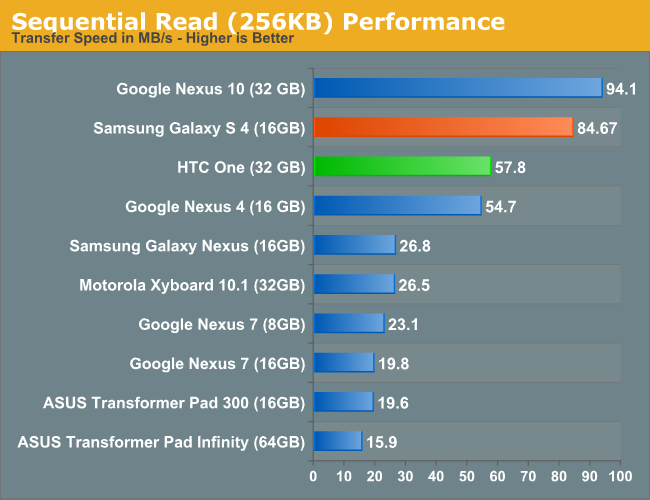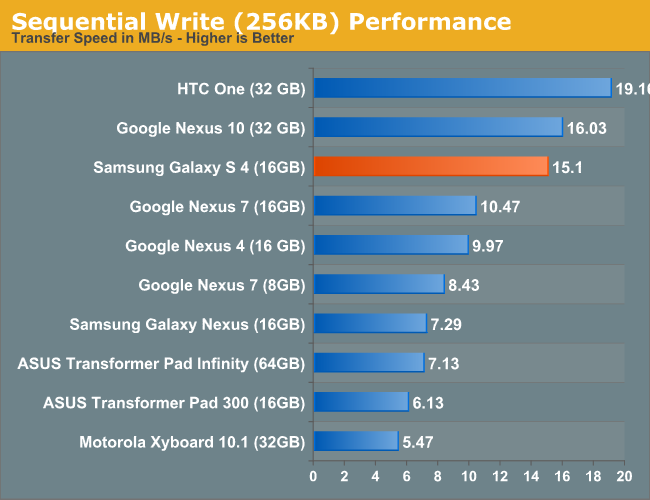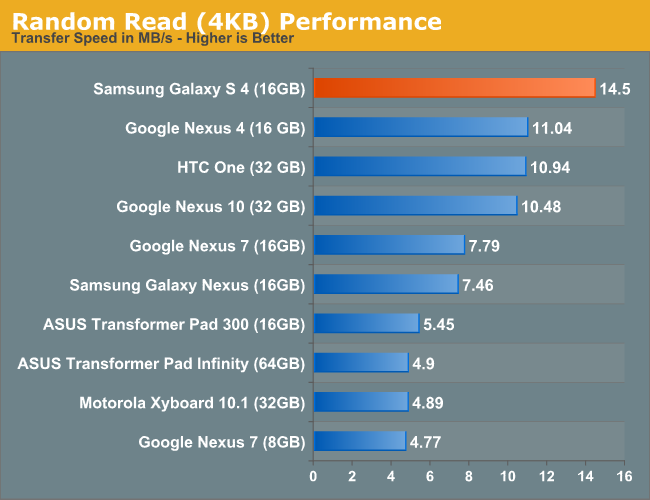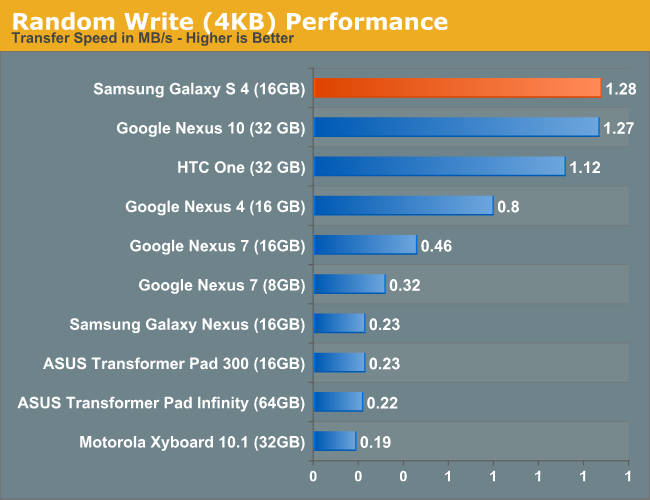Samsung Galaxy S 4 Review - Part 1
by Brian Klug on April 24, 2013 12:01 AM ESTNAND Performance
The Galaxy S 4 ships with either 16GB or 32GB of NAND on-board, but allows for expansion via a microSD card slot. The latter is a quickly disappearing feature on modern smartphones, but it remains a point of differentiation offered by Samsung. We were sampled a 16GB version of the Galaxy S 4, which arrived with 9.62GB of usable space after the OS and app pre-load.
As always we're using Androbench (with modified settings) to quantify NAND performance. Thankfully NAND performance has been steadily improving on modern smartphones/tablets, and the Galaxy S 4 is no exception. Sequential read performance actually sees a tremendous boost compared to most of the other devices in our charts here. Optimizing for sequential read performance makes a lot of sense, but it's good to see Samsung being competitive on all fronts here.
It is worth pointing out that NAND is treated very much as a commodity in these devices, and it's entirely possible that you'll see performance deviate from what we've shown here depending on what controller/NAND/firmware combination you get in your device.














335 Comments
View All Comments
krumme - Wednesday, April 24, 2013 - link
Comparing at 200 nits, is fine, but at that brightness you actually get a more contrasty picture of Oled because of the darkness. For all practical usage - depending on your eyes - you can turn brightness relatively more down on the Oled.You might note that the color accuracy of the S4 is far better than the One. Thats not to mention the contrast. Ofcourse it lacks the brightness. But the presentation here is one sided.
If you find yourself at bars at night or shooting food at the restaurant go for the One camera. But before you do, you might want to compare the pictures plenty available on the net on fx. gsmarena or phonearena
UpSpin - Wednesday, April 24, 2013 - link
If the surrounding is bright, you need a bright display, which OLED struggles at, even with a better contrast, which gets more and more negligible the brighter your surrounding is. At night however you really see the difference between the true black OLED and greyish LCD.I don't know how to properly interpret the color charts, so I judge by the impression of the author which favors the HTC One display (see the HTC One review and this review 'Admittedly this mode does tighten things up a bit, but it still isn't perfect and I'd still like to see Samsung do something to reign this in at some point. ') and the numbers in the article:
HTC One vs. SGS4
Grayscale 200nits Avg dE2000: 5.391 vs. 7.511
CCT Avg (K): 8118 vs. 7020
Saturation Sweep Avg dE2000: 3.365 vs. 7.823
GMB ColorChecker Avg dE2000: 4.656 vs. 7.440
The color charts seem to look better for the SGS4, the 'Total gamma' and greyscale charts however disastrous.
krumme - Wednesday, April 24, 2013 - link
For practical usage i agree the brightness for most people can be an issue in sunlight. We just have to remember there is much more at play here than just brightness.But at the same way using a phone in bright surroundings favor the saturation of Oled.
I never understand the standard setting on the S2 or S3. It gave stupid colors imho (and the sharpness wasnt there either imho compared to LCD competition). But if you chose fx. natural on the S3 i think you are pretty much where the colors is okey for everything personal. Its the grey scale that suffers - the shaddow details is very bad imho. Apparently thats still an issue on the S4.
But the basic problem about reviewing the display this way, is that we get zero numbers for the all important dynamics of the picture. And its just so obvious for the eye that oled got something here.
nerd1 - Wednesday, April 24, 2013 - link
What matters is the perceived CONTRAST, not the brightness itself.Practically AMOLED has better contrast overall, which helps sunlight reading a bit although bit dimmer.
sigmatau - Thursday, April 25, 2013 - link
I feel you are just guessing based on what you see on paper. My Samsung AMOLED plus screen is useless in the sun with full brightness. Most reviewers said that the HTC's screen kills the S4's screen. I am thinking of buying an HTC One and trying it out for a day or two before deciding. I really do like the blacks on OLED screens.krumme - Thursday, April 25, 2013 - link
Nonsense. Plenty sites gives the edge to Samsung. But i guess most just turn the autopilot on. Something happened since your amoled screen. Sunlight legibility is a personal matter, because reflection also plays a big role.sigmatau - Thursday, April 25, 2013 - link
Bull shit. My OLED screen is the best with Nokia's superior filter and still is terrible in the sunlight. I have to find shade just to use the phone. And remember, mine is a plus OLED screen, these on the S3 and S4 are not, which makes them worse.UpSpin - Thursday, April 25, 2013 - link
The glass reflects a lot of the sunlight.The display must be brighter than the reflections to remain readable. That's independent of contrast in the first place. So either reduce the reflections (AR coating, Nokia polarisation) or increase the brightness. The contrast isn't important in the first place here. OLEDs have a lower brightness than LCD, thus, and just as every review talking about outdoor use agrees with, LCD is much better readable outdoors.If you have a very dark display with an impressive contrast you won't see anything in sunlight, because the reflections are much brighter than the content on your display.
Special outdoor display also don't just have RGB, but RGBW, just to make it even brighter for outdoor use.
krumme - Thursday, April 25, 2013 - link
Go here to see an measurement of sunlight contrast ratio:http://www.gsmarena.com/samsung_galaxy_s4-review-9...
S4 is quite good, and if i recall about the same order as One.
ssj3gohan - Wednesday, April 24, 2013 - link
Wait a sec... you have an LTE/HSPA synthesizer, right? Why don't you try out battery life with that, so you're guaranteed to have equal signal strength, bandwidth and latency throughout the tests instead of having to rely on different vendors, signal quality and concurrency.